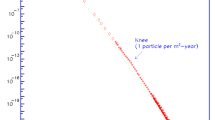Abstract
Photons and antiphotons, because they are uncharged, are considered the same particle. But this criterion would lead to the same conclusion for neutrinos and antineutrinos. These elementary particles have nevertheless an opposite leptonic number. They are different elementary particles. Special relativity makes a completely symmetric description of elementary matter and antimatter, but it seems that the only exception are photons. If photons and antiphotons are the same particle, there will be no phenomenon of electromagnetic attraction. We analyze the differences between elementary particles and antiparticles under external interactions. We make the conjecture that the main form of electromagnetic radiation of matter is by the emission of photons, while for antimatter it is the emission of antiphotons. With this conjecture in mind, we make a design of a telescope for focusing antiphotons. The nearest objects to be detected will be antimatter galaxies. The complete validity of this conjecture might depend on an experimental basis but it opens a discussion about possible differences between photons and antiphotons.











Similar content being viewed by others
References
M Rivas J. Math. Phys. 30 318 (1989)
M Rivas Kinematical Theory of Spinning Particles. Classical and Quantum Mechanical Formalism of Elementary Particles Fundamental Theories of Physics Series, vol. 116 (Dordrecht: Kluwer) (2001) An updated version of the formalism can be obtained as the Lecture Notes: https://www.researchgate.net/publication/337744818\_Kinematical\_theory \_of\_elementary\_spinning\_particles
ALPHA collaboration Nature 578 375 (2020)
R F Streater and A S Wightman PCT, Spin & Statistics, and all that (New York:Benjamin) p 29 (1964)
See reference [2], p 148-151 (2001)
M Born and E Wolf Principles of Optics (Oxford:Pergamon Press) p 36-50 (1970)
P Green et al. Astrophysical J. 571 721 (2002); arXiv:astro-ph/0202081
J M Aguiregabiria Dynamics Solver. Computer program for solving dynamical systems, which can obtained at the e-mail address juanmari.aguirregabiria@ehu.eus, from his author, at the University of the Basque Country, Bilbao, Spain
Acknowledgements
I thank my colleague Juan Maria Aguirregabiria for the use of his excellent computer program Dynamics Solver [8], for the numerical computation of the differential equation of the telescope mirror. I also thank to my colleague Alex Oscoz, from the Instituto de Astrofísica de Canarias (IAC) for the reference [7] to the gravitational lens mentioned at the conclusion section.
Author information
Authors and Affiliations
Corresponding author
Additional information
Publisher's Note
Springer Nature remains neutral with regard to jurisdictional claims in published maps and institutional affiliations.
Rights and permissions
About this article
Cite this article
Rivas, M. Considerations about photons and antiphotons. Indian J Phys 96, 583–591 (2022). https://doi.org/10.1007/s12648-021-02035-y
Received:
Accepted:
Published:
Issue Date:
DOI: https://doi.org/10.1007/s12648-021-02035-y




